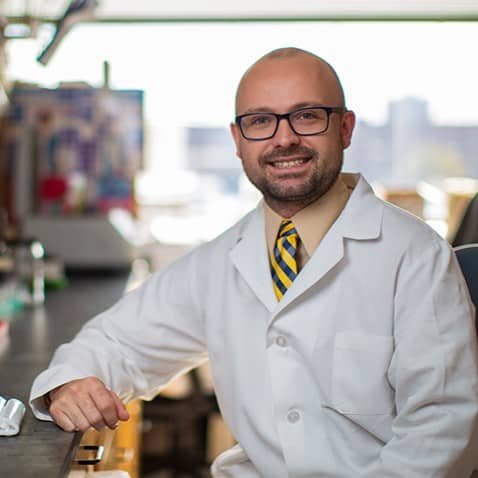
Triple negative breast cancer (TNBC) is a type of breast cancer that grows and spreads more aggressively than other types, is more difficult to treat and more likely to recur. These challenges are compounded for Black women, who are twice as likely to be diagnosed with TNBC compared with white women and 30% more likely to die from these tumors.
While recent advances in treatment have shown promise for TNBC patients, there is a critical need for new research and clinical trials that will identify the right therapeutic targets for more effective treatments and address the existing disparities in treatment outcomes experienced by Black women.
New Komen Researcher Nathan Merrill, Ph.D., a research investigator in the Department of Internal Medicine at the University of Michigan, is seeking better treatment options for TNBC patients. Through this Komen-funded research, Dr. Merrill hopes to give patients an alternative to the standard “one-size-fits-all” treatments for TNBC that often leave unwanted side effects. Dr. Merrill has seen firsthand how these complications can affect a loved one.
“I have a grandmother who’s a breast cancer survivor,” he says. “She has no evidence of disease, but her treatments have done irreparable damage to her heart. There’s a clear need for improved therapies to spare patients from toxicity and to provide more options to those who aren’t cured when they undergo standards of care.”
Making a Difference Because of Komen
Dr. Merrill was recently awarded a Komen Career Catalyst Research grant for his project “Novel Therapy to Inhibit DNA Repair Mechanisms and Prevent Tumor Cell Division in Ethnically Diverse Breast Cancer.” In this study, he will evaluate a novel combination of two drugs that could offer a new therapeutic strategy for TNBC.
The inspiration behind Dr. Merrill’s work comes from the use of PARP inhibitors to treat breast cancer associated with an inherited BRCA gene mutation. With BRCA mutations, cancer cells are unable to repair their own broken DNA strands, and PARP inhibitors further impair the cell, causing a snowball effect that results in cell death. Dr. Merrill plans to use a similar treatment strategy to impair and kill TNBC cells.
Dr. Merrill will also use a precision medicine approach to identify biological markers that could indicate those who would respond to this new treatment by using preclinical models that were derived from an ethnically diverse patient population. Once these biomarkers are identified, it can help guide patient selection for future clinical trials of this promising treatment.
Exploring the Role of Ethnicity in TNBC
Even while it is understood that race impacts the outcomes of TNBC, many of today’s preclinical studies use models of unknown diversity, which make it difficult for researchers to understand the role of ethnicity in the disease.
“Published work, even just from our lab, has revealed that there are ethnically distinct gene expression patterns in TNBC,” says Dr. Merrill.
For this research, Dr. Merrill will use a unique resource in his lab that can function as a realistic human model with TNBC. Tumor samples collected from a diverse patient population are grown in preclinical models, illustrating how patients of different ethnicities could respond to a treatment.
This could be a major advancement for future clinical trials as researchers are challenged to find participants from under-resourced populations, especially those from Black communities, whose participation is critical to finding better treatments for TNBC.
Looking Ahead: A Brighter Future for TNBC
Like PARP inhibitor treatments for BRCA mutations, Dr. Merrill’s upcoming study is another excellent example of the many possibilities that come from precision medicine.
“There’s a continued expansion of precision medicine to pair the right patient with the right drug,” says Dr. Merrill. “That’s really exciting, and it’s an area where we’re just scratching the surface.”
Clinical trials will soon be able to offer TNBC patients even more opportunities to test innovative, more personalized therapies that could soon become the standard of care. Grants and projects funded by Komen, like Dr. Merrill’s work, are bringing us one step closer to that.
“Of course, there’s a long way to go, but I think that many of the recent advances in the clinic do offer a lot of hope,” says Dr. Merrill. “We have a lot of work to do, but there’s a very bright future ahead.”



